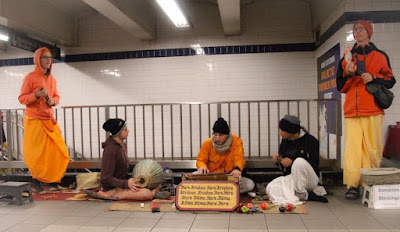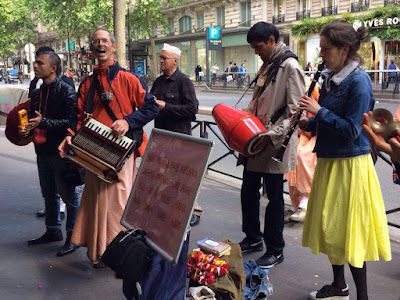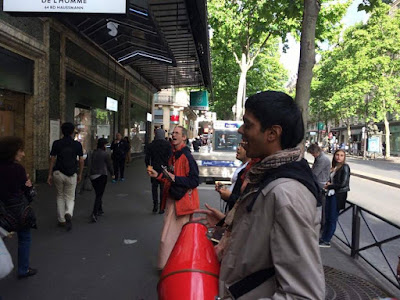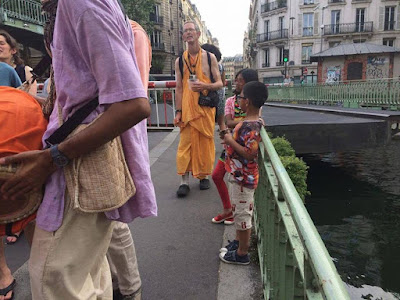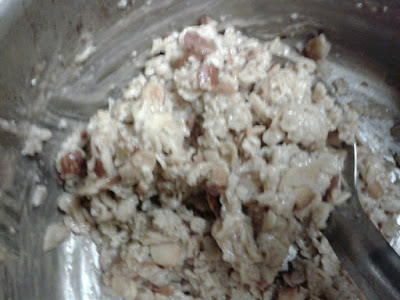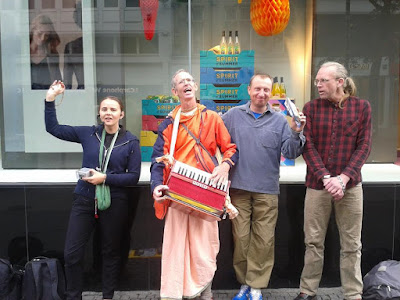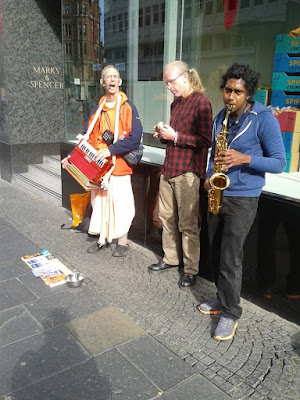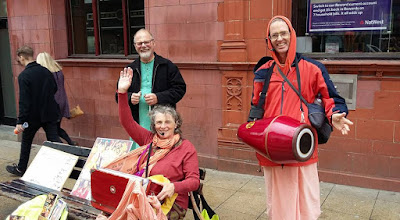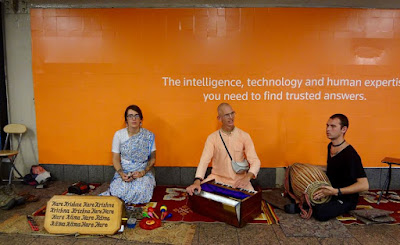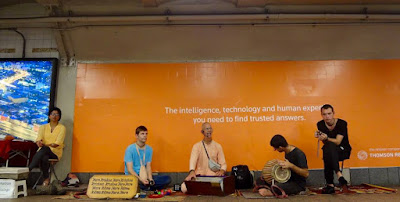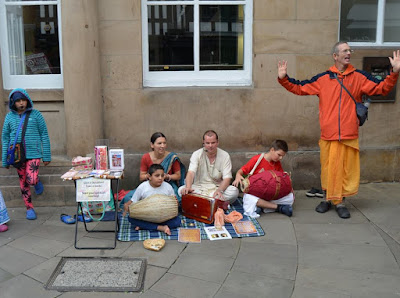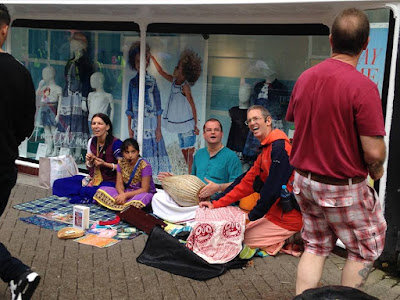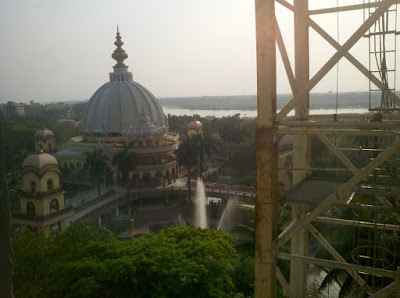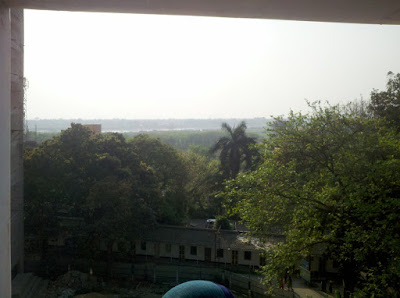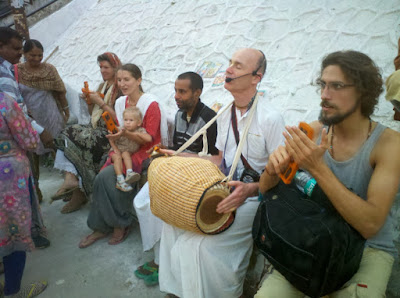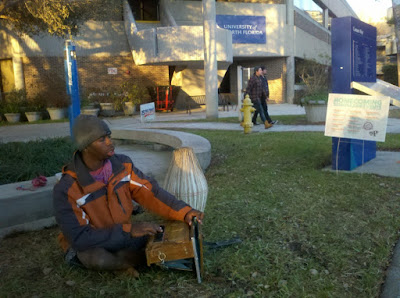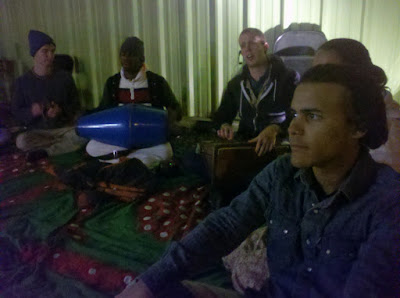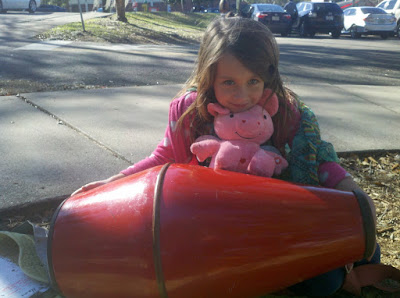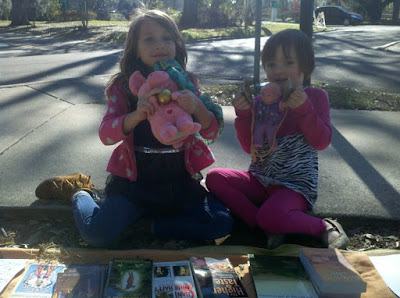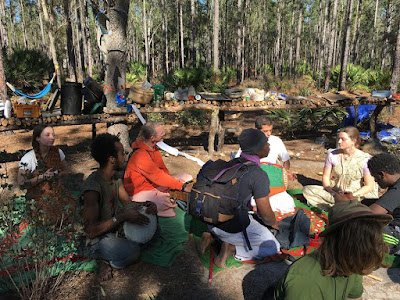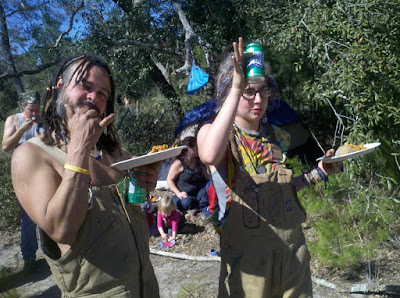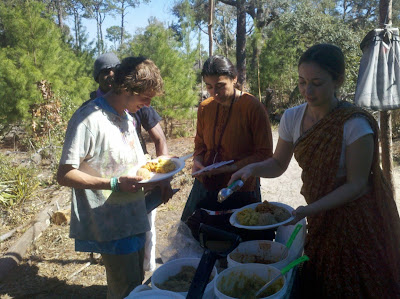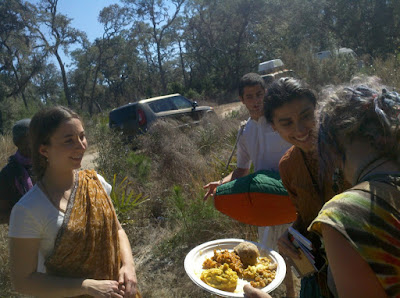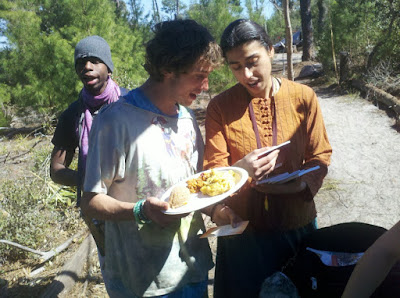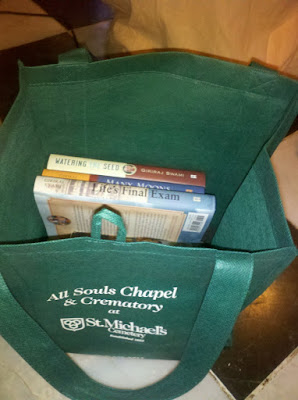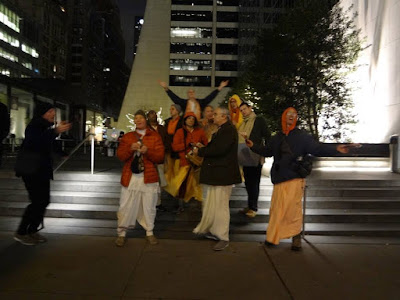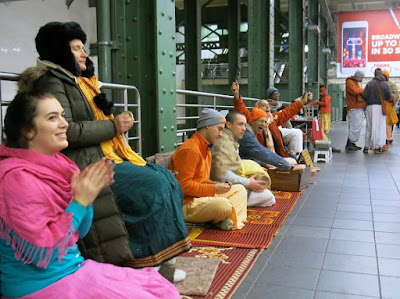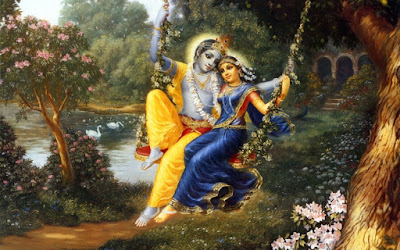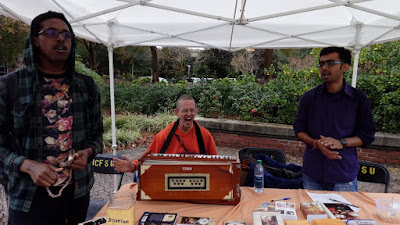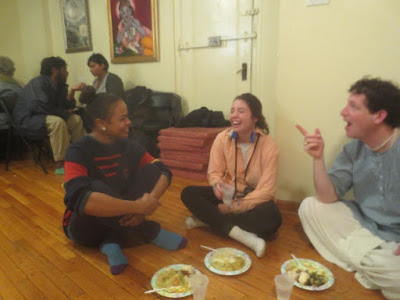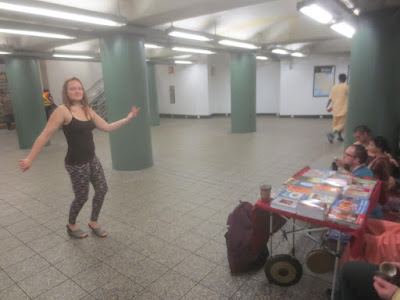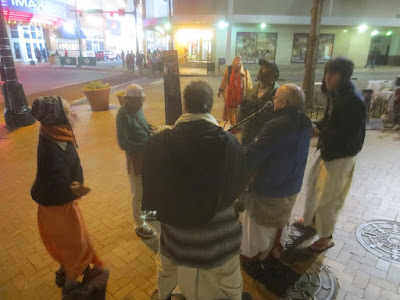Diary of a Traveling Sadhaka, Vol. 16, No. 15By Krishna Kripa Das(August 2020, part one)Orlando(Sent from Tallahassee on August 21, 2020)Where I Went and What I DidI continued doing pujari work for three hours each morning at ISKCON Orlando, where I li…
Author Archives: Krishna-kripa das, Mayapura
Travel Journal#16.15: Orlando
Nectar from Srila Prabhupada Tributes 2020
→ Travel Adventures of a Krishna Monk
Nectar from Srila Prabhupada Tributes 2020While proofreading Srila Prabhupada Tributes 2020 I encountered so many inspiring realizations, stories, and poems in glorification of Srila Prabhupada, I cut some of my favorite out to share with you her…
Travel Journal#16.14: Orlando
→ Travel Adventures of a Krishna Monk
Diary of a Traveling Sadhaka, Vol. 16, No. 14By Krishna Kripa Das(July 2020, part two)Orlando(Sent from Orlando on August 7, 2020)Where I Went and What I DidI continued staying at ISKCON Orlando and doing pujari service in the morning and chanting Hare…
Travel Journal#16.13: Tallahassee and Orlando
→ Travel Adventures of a Krishna Monk
Diary of a Traveling Sadhaka, Vol. 16, No. 13By Krishna Kripa Das(July 2020, part one)Tallahassee and Orlando(Sent from Orlando on July 24, 2020)Where I Went and What I DidI continued staying in our Tallahassee temple, chanting Hare Krishna for three h…
Travel Journal#16.12: Tallahassee
→ Travel Adventures of a Krishna Monk
Diary of a Traveling Sadhaka, Vol. 16, No. 12By Krishna Kripa Das(June 2020, part two)Tallahassee(Sent from Tallahassee on July 3, 2020)Where I Went and What I DidI continued chanting Hare Krishna three hours a day, mostly on the porch of our ISKCON Ta…
Travel Journal#16.11: Tallahassee
→ Travel Adventures of a Krishna Monk
Diary of a Traveling Sadhaka, Vol. 16, No. 11By Krishna Kripa Das(June 2020, part one)Tallahassee(Sent from Tallahassee on June 19, 2020)Where I Went and What I DidI continued staying in Tallahassee and chanting Hare Krishna three hours every day on th…
Travel Journal#16.10: Tallahassee
→ Travel Adventures of a Krishna Monk
Diary of a Traveling Sadhaka, Vol. 16, No. 10 By Krishna Kripa Das (May 2020, part two) Tallahassee (Sent from Tallahassee on June 5, 2020)Where I Went and What I DidI continued staying in the Hare Krishna temple in Tallahassee, cha…
Travel Journal#13.22: New York City
→ Travel Adventures of a Krishna Monk
By Krishna-kripa das
(November 2017, part two)
New York City
(Sent from Hartford on December 11, 2017)
Where I Went and What I Did
“Therefore the conclusion is that ‘Don’t try for your so-called happiness or so-called distress. Try to achieve that position where you can understand Krishna and get shelter at His lotus feet.’”
From a lecture at The Bhakti Center on Gita Jayanti:
From the very beginning of the GitaKrishna tells Arjuna that each of is eternal and individual. Our nature is to serve the Lord and to love the Lord.
To awaken the dormant love of God in our hearts is the perfection of yoga.
The sun ray is not the cause of the sun, but the sun is the cause of the sun ray.
Prabhupada defined bhaktias devotional service because when we love we want to serve.
God’s happiness is my happiness. God’s will is my will.
Krishna says in Bhagavad-gita 18.66 “live in the spirit of love.”
When the leaves falls from the trees we see it is beautiful. Death can also be seen as beautiful.
Bhagavad-gitawas spoken to activate Arjuna to act in this world but not be of this world.
A warrior is the last person you would think to talk to about peace and love.
When our mind is acting in harmony with our soul it is our friend.
According to our association and activities we are controlled by the ropes of material nature. Bhagavad-gitatells us how we can become free.
Bhagavad-gita4.7 tells how the Lord is always coming to deliver us.
Srila Prabhupada said that to awaken the innate love for the Supreme in our hearts is religion.
Krishna says one who is advanced in love for Him sees all living beings equally (Gita 5.18).
By applying the basic principles of the Gitain our lives we attain perfection.
The Gitateaches us how we can live in this world and remain pure like a lotus and really make a difference. Haridasa Thakura said the goal of kirtan is prema,unconditional ecstatic love for God and all living entities. We should pray to be free from false ego and situated in love of God. We should desire to be an instrument of God’s love. Nagaraja Prabhu:
Caitanya Carana Prabhu:
Radhanath Swami says:
“
The sirens remind us there is suffering in this world.”“
What good is there in being eternal and full of knowledge if you are not happy?”Travel Journal#13.10: Paris
→ Travel Adventures of a Krishna Monk
(May 2017, part two)
Paris
(Sent from Paris on June 12, 2017)
While going to attend that program, one dayon a crowded bus in a Paris traffic jam, two guys had a heated argument which disturbed my mind and those of others. Some people tried unsuccessfully to stop them. After a while I picked up my harmonium and chanted Hare Krishna kirtan softly for two minutes, and they quieted down. A couple of people smiled broadly in appreciation. The guys rekindled their argument after a few minutes, and I chanted again. This time they quieted down after half a minute. Chanting Hare Krishna is the solution in this age of quarrel.
Astanga yogic perfections easily distract one from attaining perfection.
While in the material world you cannot really enjoy the impersonal Brahman.
We cannot manifest our personal qualities when we are isolated from others.
Bhaktiis completely different from any other activity because the theory, the practice, and the goal are the same.
There are “believers” who we do not consider transcendentalists. Even there are demons who believe in God.Those who attend church weekly and feel themselves purified so they can begin another week of sinful activities we cannot consider transcendentalists.
When we are in front of a plate we should consider that Krishna has given us this prasadam.
Our effort to please Krishna and how much we want to please Krishna are more important than the results of our activities.
We cannot cheat Krishna.
Transcendental knowledge is not the goal but the satisfaction of Krishna is.
Union of the soul with God is yoga, but union of man and woman is not called yoga, yet both theman and woman can be yogis if they are individually linked with God.
Krishna is the center of everything. In our conditional life we put things other than Krishna in the center of our lives. Krishna wants to enter, but there is no room.
Surrender means considering “I am yours.” The soul must come to take pleasure in being dependent.
Radha feels She has no love for Krishna because She did not die when separated from Him.
Our sense data is inaccurate, and so we are in illusion.
If you have people in the three different modes together they will not be able to work together because
of different interests.Krishna disappears when the love of the devotee reaches its climax in order to increase
that love. Then he reappears when the feeling of separation becomes unbearable.When we take birth in an animal form our consciousness is restricted by the form. That is not the case when Krishna incarnates as an animal.
We should know whatever we put on the plate to offer already belongs to Krishna.
A nondevotee could never accept the idea of serving the Lord no matter how the Lord chooses to reciprocate.
When Krishna sees one has an attachment that he cannot give up, He arranges that the devotee can engage it in His service.
Jesus would be less glorified had the Lord not allowed him to be crucified.
Christ said many things, and the Lord had to allow the crucifixion to happen for those words to come true.
Krishna is amazed by the activities of His devotees, and we are also.
Suffering is caused by attachment. If we see something as the property of Krishna and not ourselves, it will cause us to suffer less.
Judas is seen as evil, but he was a faithful follower of Christ, and it was his service to betray Christ.
Comment by Mandakini Devi Dasi: The Russian devotee Ananta Shanti told me he was imprisoned in such an extreme way he prayed to Krishna that he did not see how he could tolerate it. A Bhagavad-gitaverse came clearly to him about how the soul is indestructible, and he became peaceful, realizing that they could not harm his soul.
Travel Journal#13.5: North Florida
→ Travel Adventures of a Krishna Monk
(March 2017, part one)

Chanting Hare Krishna at Lake Ella in Tallahassee
mahat-padam punya-yaso murareh
bhavambudhir vatsa-padam param padam
padam padam yad vipadam na tesam
Travel Journal#13.3: North Florida
→ Travel Adventures of a Krishna Monk
(February 2017, part one)
On Sunday, devotees from Gainesville’s Krishna House and Jacksonville’s Bhakti House chanted in Ocala National Forest at the Ocala Regional Rainbow Gathering for six hours, also distributing prasadam and books. The next three days I chanted with Krishna Club students at the University of North Florida in Jacksonville. I also attended the Monday evening program at the Jacksonville Bhakti House, and I chanted with Youssef and Richie at the Jacksonville Beach Art Walk on Tuesday.
I have a nice quote by Srila Prabhupada about the importance of the association of spiritually minded people. I share an excerpt from Satsvarupa dasa Goswami’s Begging for the Nectar of the Holy Name. I share notes on lectures by Mother Madhumati, Caitanya Carana Prabhu, Ekayani Devi Dasi, Abhimanyu Prabhu, and Bhakta Hanan.
A couple ladies stopped by at different times and said they had often seen me singing on the green and they wondered what it was all about. That just reminded me about how important it is that devotees go out in public and represent Krishna in order to create an interest in Him.
Tulasirani Devi Dasi really has a taste for talking with people.
We served sabji, halava, and salad.
This person, after having gotten some prasadam, chose some spiritual literature.
Megan, holding her son, was happy to encounter the devotees again. She told me that once Adikarta Prabhu did a program at her house, and she said, “I owe that man my life!”
Travel Journal#13.2: North and Central Florida
→ Travel Adventures of a Krishna Monk
(January 2017, part two)
Chanting Hare Krishna in Tallahassee
15 Butter and honey shall he eat, that he may know to refuse the evil, and choose the good.
Travel Journal#12.17: North UK, Ireland, and New York City
→ Travel Adventures of a Krishna Monk
(September 2016, part one)
Thanks to Govardhan Dasi for her photos of our harinamas in Hull and Scarborough. Thanks to Joe Kenny for his photos of our Sheffield harinama. Thanks to Narinder Singh for his photo of us chanting in Belfast. Thanks to Stella Montoya for her photos of New York City Harinam in Grand Central Station.
Thanks to Bhagavati Dasi, who is always ready to go on harinama for three hours every day when I visit Belfast, and thus makes going to Belfast a pleasant experience.
Janananda Goswami came out with us one day in Belfast, and as always, more devotees came out and more people interacted with our party than usual, as you can see in this video (https://youtu.be/M4xXdR8pMmg):
Thursday is one of two weekly harinama days in Belfast, and we had seven devotees in our party that day.
Narinder Singh, a devotee of Krishna who passed by and was happy to see us, took a photo of his son with our party, and sent it to us.
The next day the weather was not so nice, so we had to chant in Grand Central station.
The intelligence, technology and human expertise you need to find trusted answers all comes from chanting Hare Krishna. When the heart is purified by chanting, you can hear the Lord speak from within:
Travel Journal#12.16: Czech Woodstock, Prague, Newcastle, Chester, Edinburgh
→ Travel Adventures of a Krishna Monk
(August 2016, part two)
On our first harinama, we passed a vendor of flower crowns, and the devotees tried them on.
The first night I was surprised to see one girl chanting and dancing in our tent named Eliska (in the center of the above picture), who I remembered from 2009. She and some high school friends really enjoyed chanting and dancing in the kirtana so much back then (https://youtu.be/bWcHj6U9ijM):
(1) faith in their message
(2) faith in their desire to spread the chanting all over the world
Faith in the holy name:
Karsna Prabhu, Aharada Devi Dasi, and Mark of Chester are my favorite harinama family. It is not so often that both parents and the kids go on harinama.
In Chester there are many people on the streets, and although there is often too much competition with other musicians, it was not so bad this time.
We chanted on Saturday for three hours in downtown Chester, accompanied by Alan, the main leader of our Liverpool nama-hatta and Kamalaksi Devi Dasi, the nice Indian lady who cooks for that program.
The next day we chanted for two and a half hours with Chand and his wife (not in picture), daughter, and son. The second day two older ladies came by independently of each other, and both were attracted enough to attend our semiweekly program that night. One had a serious interest in yoga and different religions, and I would not be surprised if we see her again.
Here in Newcastle-upon-Tyne, however, the glorious transcendental name of Balaji is associated with beers and spirits, and “off-licence.”
If you are non-British, you may wonder, as I did, what does “off-licence” mean? Apple’s dictionary says, “A store selling alcoholic beverages for consumption elsewhere.” Such is the degradation of this age!
upayuktam yadrcchaya
ajanato ’py atma-guṇam
kuryan mantro ’py udahrtah
Travel Journal#12.11: From Newcastle to London
→ Travel Adventures of a Krishna Monk
(June 2016, part one)
Northampton Ratha-yatra, Chester, London
(Sent from London on June 17, 2016)
Dayananda Swami chanted at our Wednesday night kirtana, and I share this video of that (https://youtu.be/CLeRWZwFgPA):
Speaking of Sheffield, we take this opportunity to congratulate Mariana of Ukraine, who has been regularly active in the Sheffield nama-hatta for several years, and who was just initiated by Indradyumna Swami this month as Madhavi-rani dasi. We hope she is steady in her service to her guru and she attains spiritual perfection as a result.
Two young Italian ladies (above, in black), one based in London and the other visiting her, danced with the female devotees for half an hour as our chanting party proceeded through Covent Garden on our second day of chanting Hare Krishna in London with Harinama Ruci and the Soho devotees. In one bar, the staff behind the counter enjoyed dancing until the boss lady came upstairs and made us stop and leave. Glasgow students delighted in chanting and dancing with us at Leicester Square. It was a lively day as you can see (https://youtu.be/Rd7ytH1E6Y8):
The girl on the left, who is swinging with Mangala-vati Devi Dasi, is the girl I asked where the kids came from and who told me Glasgow. I told her that we had a farm in Lesmahagow and programs in Edinburgh. She said she knew of Lesmahagow but that she lived nearer Edinburgh. I gave her my card, and said I could tell her the addresses of our places.
From classes in Newcastle:
Travel Journal#12.10: The North UK
→ Travel Adventures of a Krishna Monk
(May 2016, part two)
Liverpool, Karuna Bhavan, Glasgow, Edinburgh
(Sent from Newcastle-upon-Tyne on June 8, 2016)
July 2: York harinamaand nama-hatta
July 4–5: Preston, Blackpool, and more
July 6: Newcastle
July 7–9: Polish Padayatra
sac-cid-ananda-vigraha
where speech is song,
walking is dancing and
the flute is the constant
companion. There are
numberless Surabhi cows
who moisten the ground
with their nectarean milk,
and Krishna is served by
millions of gopis or
goddesses of fortune.
But there is one who is
His favorite
who captivates Him and is
superior in everything and
controls Him completely.
That is Radha.
The residents of Vrindavana take shelter of
Her and cry out
‘Jaya Radhe!’ because they know if they get the
favor of Radharani She rewards them and
Krishna is obliged
to give them His mercy. We should know the blessings
of Radharani come through Lord Caitanya
who is a combination of Radha and Krishna.
He is Krishna
in the complexion and mood of Radharani in separation.
Follow Lord Caitanya’s sankirtana and receive the blessings of Radha and Krishna.
I am grateful Radha-Govinda reside with us in Viraha Bhavan.”
Travel Journal#12.5: Mumbai, Mayapur, Rishikesh
→ Travel Adventures of a Krishna Monk
(March 2016, part one)
(Sent from Vrindavan on March 22, 2016)
It will have a dome with a volume greater than any other dome in the world.
The view is wonderful of the Prabhupada Samadhi and the Ganges River in the distance.
Apparently they have to collect 1.5 million dollars a month to finish it at the desired time. All the different levels of planetary systems, spiritual and material, will be depicted.
That morning my friends told me that Jayadvaita Swami would speak at 10:30 a.m. at the old gurukula, and I decided to go hear him first and catch the end of the marriage.
Turns out I knew the couple taking vanaprastha, two disciples of my Guru Maharaja, Satsvarupa dasa Goswami, named Jaya Gaurasundar and Kaumodaki Devi Dasi from Baltimore, so it was especially nice I was able to attend. By notes on his very nice lecture are included in the “Insights” section before. As it turned out, the lecture did not happen until 12:20 p.m., and I missed Jagannath’s darsana, but fortunately not the wedding prasadam, which was very nice, and the opportunity to sit with my friend from the UK, Gaura Krishna Prabhu, who was leaving the next day. I also gave the couple a small gift and wished them well. Jayadvaita Swami considered it Krishna’s mercy that I missed all of the wedding but the prasadam.
intrude when you
are chanting japa. That’s
the peak performance
of the day. So it should not be
a discussion of “Things to Do.”
That’s why it’s important
to rise early in the morning after sufficient rest
before the day increases in the modes of passion.”
a day, which is a strenuous
yajna. But they enjoy
every minute of it
glorifying the Lord.
The people who pass
by are interested in the phenomena, and
the regulars have memorized the mantra. What they
don’t know is that they are having
their sinful reactions removed and
seeds of love of Godhead
planted in their hearts
by hearing. It is a secret
revolution going on in
the City. The chanters
are the instruments, and Krishna is in control.”
responsibility. They
are carrying out the
legacy of Lord Caitanya to
deliver congregational chanting
in the Age of Kali.
If they did not
report for duty
the City would be
void of auspiciousness.
If they did not come
out and hold kirtana,
the rogues and thieves
would take over the
square. By singing
in their sacred spot,
they are staving
off maya’s influence.
to keep themselves fit
and keep going out on sankirtana.”
Today I read the verse
spoken by the Supreme Lord
to Narada where He says,
‘I am not in My abode
in Vaikuntha, or in the
heart of the mystic yogis.
I am wherever My
pure devotees chant
My names and discuss
My pastimes.’ This is
very encouraging for the
Hare Krishna chanters in the City.
The Lord says He is with His
‘pure devotees,’ and the
kirtaneers are certainly
pure devotees. Their lives
are completely dedicated
to chanting the holy names.
They are compassionate, because
they chant publicly for
the benefit of the conditioned souls.
They can be aware and assured
that Krishna is personally present with them
as they perform kirtana of the Hare Krishna mantra.
The Lord says He is there wherever
devotees gather to chant, so it
is not restricted to the temple.
He is there with them in the city streets all day long.”
by, and the tourists keep coming,
hearing the harinama chanting.
But they should be aware
that time is precious. The
passing away of the great
sankirtana devotee, Jada Bharata,
reminds us that we all must
die one day. So seize the
opportunity while health
is with you, to serve
in the kirtana party
and go out every day to
distribute harinama
to the conditioned souls.
Don’t waste a minute. Time is
passing, and you can’t get a minute
back if you paid a million dollars.
Chant Hare Krishna and be happy.”
Travel Journal#12.4: North Florida, New York City Harinam, Dublin
→ Travel Adventures of a Krishna Monk
(February 2016, part two)
(Sent from Rishikesh on March 15, 2016)
She as been coming for three or four weeks and is very regular, despite being so young.
The first week one guy also joined us, listening for over an hour and sometimes playing the tamborine (https://youtu.be/QkdYtlatGpY):
That was Bali, who may just be the most enthusiastic in kirtana in Krishna House. We chanted for two and a half hours or so on the campus of the University of North Florida, and then attended the Krishna Club program. Bali liked Krishna Club very much. I described some of the glories of Lord Nityananda as the next day was His appearance day. Youssef led a lively final kirtana that got a few of the students dancing, and that was beautiful to see (https://youtu.be/w8IU1gEgFik):
This family was attracted to the chanting, and one kid holds a Krishna pamphlet.
Here are some highlights I recorded on video (https://youtu.be/xWJ9Teeua3g):
“There are many things I will have to sacrifice when I leave this solitary base for preaching tours. However, the one thing I hope I can keep with me is turning to Krishna as much as possible. It doesn’t take extra time, it takes quality. This is something I can learn to do here and do wherever I go, because Krishna is everywhere. He is always in our heart. In fact, there may be even more impetus for talking to Krishna and praying to Him in stressful situations. My dear Lord Krishna, please have mercy on this sinner. Dear Srila Prabhupada, please help me to be a devotee of Krishna by your grace. My dear Lord Krishna, please help me to be a sincere and faithful disciple of Prabhupada.”
prayer, Jagannatha Swami nayana-
patha-gami bhavatu me:
“O Lord of the universe, kindly
be visible unto me.” You
see the statue, but if you
want to see the Lord, He has to reveal
Himself to your eyes.
Lord Krishna says, ‘I am
not manifest to the nondevotees.
I cover Myself with My curtain of maya.’
You want me to see You
with Radha beside You,
I just have to become submissive.
The praying is what will work.
Please help me to be pure.”
City are not of this
material world. They
are followers of Lord Caitanya
and Srila Prabhupada who had
spiritual forms. The sound vibration
made by the chanters
is transcendental, and they are
also transcendental. Srila Prabhupada used
to say the ISKCON temples
were not situated in
Los Angeles or London, but
they were part of the
spiritual world. The
City chanters are not
in a temple, but they
have transformed their
sacred spot into the
consciousness of Vrndavana. The passersby
are aware the chanters have created
a peaceful oasis amidst the urban
world of passion and ignorance. As
they appreciate the singing, their lives
are transformed.”
Travel Journal#12.3: North Florida
→ Travel Adventures of a Krishna Monk
By Krishna-kripa das
(February 2016, part one)
(Sent from Mayapur on March 10, 2016)
One young lady, who delighted in dancing with us, told me she had danced with us at a previous Art Walk.
I wrote down the details of our University of North Florida Krishna Club for at least five people who were attracted by the chanting and the literature. I was happy how everything worked out well and everyone had a great time, although I was the leader and our party was smaller than usual. We were blessed with excellent weather. Although the first week in February, even at 9 p.m. when we ended, I was warm enough wearing a short-sleeved kurta.
One guy listened to us for half an hour. He told me he first became interested in Hare Krishna in New York City, hearing and getting a book from the devotees who chant in Union Square, but he had recently moved to Tallahassee. He remembered some of the names of the devotees on that Union Square harinama party. He said he was planning to look up our temple in Tallahassee but was too busy getting settled to do that. He came to First Friday and some people told him that the Hare Krishnas were serving food and explained where, and so he joined us. I invited him to the Tallahassee temple and he came for two Gita classes and developed friendly relationships with Nama Kirtan Prabhu and Elias. I found out he worked for a company that collected food that was past the expiration date and arranged to give it to charities, and I invited him bring some of the food to the temple. He brought 15 avocadoes on his next visit.
Audrey (on right) and Nickole talked to some of the young people who enjoyed listening to us. In conversation, Nickole discovered that one of them had gone to the same high school as she did in Miami.
At the end, Gauranga Prasad Prabhu led harinama not just once, but twice, around the Railroad Square. The organizers of an art and music festival to be held at the Square later in the month, upon hearing us sing, invited us to perform at it. Again I was so happy my friends at Krishna House came and shared their enthusiasm for devotion to Krishna with others.
At least seven kids were excited to play my instruments as I sang for three hours on a sunny but brisk North Florida winter day. I would show the kids the standard one-two-three karatala beat and the four different sounds you can make with the drum, open and closed on the big and small ends. Then I would let them play as best they could, without additional instruction, as my mission was to allow people to hear the chanting of Hare Krishna and not teach the playing of musical instruments.
They were happy playing with me and stayed longer than I would have expected. The parents did not object much to the kids associating with me.
We met one guy who very, very happy to get Bhagavad-gita. One young mother told us that she read Bhagavad-gita every night to her child as the kid was taking rest. While serving prasadam and while people were eating it, we would chant. Then we would move on to the next group of people. Usually we go into the forest looking for people, but this year we found enough people parked and camped along the road that we were fully engaged. We had brought five buckets of halava, each a different flavor, from the five days of Krishna Lunch that week. The mint carob was especially tasty. The peach was pretty good too. At the end, I went to each of the different Rainbow kitchens to donation the rest of the halava. The lady, who was in charge of the first kitchen where we played earlier in the day, was very happy to take a bucket of halava. She said that for the moment she is living in the Gainesville area, and I invited her to come visit us sometime. The Jesus Kitchen took the last two buckets of halava. Some people sang with us or played their instruments. One young guy who sang with us a while helped pull our cart of prasadam. Thanks to all the devotees who came and made it possible to share Krishna music, food, and books at that event.
comes from Krishna in the heart.
A devotee shouldn’t
chant hoping to
get personal, creative
ideas. He should pray to serve
Krishna nicely. We are
not egoistic creators
but ‘subordinate lovers of the Supreme.’”
devotees dancing and chanting
with upraised arms.
They are happy and jumping.
Even if harinama devotees
are chanting sitting down,
they are dancing
in their hearts. The
more enthusiastic and
physically nimble among
them will actually get
up and dance. This
adds to the ecstasy.
Lord Caitanya and His associates
used to chant and dance.
The people were so amazed
at Mahaprabhu’s
physical manifestations.
He used to leap high, and
Lord Nityananda would run beside
Him to catch Him if He fell. We
may not be so empowered and
we may be growing old and
not inclined to dance, but
on occasion, we may rise to our feet
and fill our spirit
and the spirit of the group
and what to speak of the onlookers!”
the City go out every day
and situate themselves
in public in a sacred spot.
They sing kirtana for long
hours and purify the
atmosphere. They do
congregational chanting
of the Hare Krishna mantra, which is
the only sacrifice recommended
for the Age of Kali.
They are doing the
most important
welfare work for
humanity because
the chanting removes
sinful reactions and
awakens love of Godhead
in the hearts of those who hear.
No other philanthropic or altruistic
work is as important
because all other endeavors cannot
break the cycle of repeated birth and death.
Harinama can do that, and that is why
its servants are the best friends and rescuers.”
Travel Journal#12.1: New York City Harinam, Atlanta, and North Florida
→ Travel Adventures of a Krishna Monk
By Krishna-kripa das
(January 2016, part one)
(Sent from USF, Tampa, Florida, on, February 18, 2016)
Not only did we chant there on New Years Eve, but on New Years Day as well (https://youtu.be/SJspozyyDjQ):
Still Deva Madhava Prabhu chanted a very fired-up kirtana getting the devotees dancing (https://youtu.be/7m91FGuzDik):
It was wonderful how many devotees came out.
https://www.facebook.com/audrey.hunsicker.77/videos/vb.100006459198285/1948113685413919/?type=2&theater
I was so pleased that two devotees who are students joined me for some time almost every day, and they also helped set up the table and carry the books and instruments.
They were Dorian (left), who I knew from when he attended the University of North Florida and later lived in Krishna House, and Naman (right), a Ph.D. in optics who is the president of our club on the UCF campus.
Sravan Ananda Prabhu saw my enthusiasm for more harinama, and he decided we could go to an Indian store named Patel Brothers and chant, collect donations and sell books.
Verse 1
What power does the Name
of Krishna possess?
My heart constantly burns
in the fire of worldly desires
just like a desert scorched
by the rays of the sun.
The holy name, entering the core
of my heart through
the holes of my ears
showers unparalleled nectar upon my soul
Verse 2
The holy name speaks from
within my heart,
moves onto the tip of my tongue
and constantly dances
on it in the form of transcendental sound.
My throat becomes choked up
my body shivers again
and again and my feet cannot remain still.
Verse 3
Rivers of tears flow through my eyes;
perspiration completely soaks
my body. All my skin thrills with rapture,
my hairs stand on end
and my complexion turns pale
and discolored. My mind grows faint.
I begin to experience devastation
and my entire body is shattered in
a flood of ecstatic emotions.
Verse 4
While causing such an ecstatic disturbance,
the holy name showers
nectar on my heart
and drowns me in the ocean
of divine love of Godhead.
He does not allow me to understand anything
for He has made me truly mad
by having stolen away my mind and all my resources.
Verse 5:
Such is the behavior of Him
in whom I have taken shelter.
I am not capable of describing all of this
the Holy Name is independent
and thus acts on its own sweet will.
In whatever way He becomes
happy that is also my
way of happiness.
Verse 6:
The Holy Name is the bud
of the flower of Divine Love
and is the very abode of the
astonishing mellows.
Such is the power He manifests
that when the Holy Name starts
to blossom a little further
that reveals its own divine form
and qualities. Thus my heart is abducted
and taken directly to Krishna.
Verse 7:
Blossoming fully the flower
of the Holy Name takes
me to Braja and reveals to me His own love-dalliance.
This Name gives to me my
own eternal spiritual body, keeps me right by Krishna’s side,
and completely destroys
everything related to this mortal frame of mine.
Verse 8:
The name of Krishna
is a transcendental touchstone, a mine of all devotional mellows
is eternally liberated
and the embodiment of pure rasa.
When all impediments in pure chanting
of the Holy Name are taken away
and destroyed then my happiness will know its true
awakening.
Satsvarupa Dasa Goswami:
“Harinama devotees
bring relief to people
with disturbed minds.
They have appeared at
scenes of recent disasters
or riots and spread
a calming influence.
The positive-mindedness
of the chanters offsets
the gloom and depression
present in intense situations.
God’s holy names have
the power to calm
agitated minds. Even in intense scenes
of material enjoyment,
at gatherings before
rock concerts or
sporting events, it
is good to share
harinama to bring
a level of sanity
and spiritual presence.”
Amala Bhakta Swami:
2nd note: Yamuna flows backwards
People advance spiritually, even without their knowledge!
Travel Journal#11.24: New York City Harinam and Albany
→ Travel Adventures of a Krishna Monk
By Krishna-kripa das
(December 2015, part two)
(Sent from Gainesville, Florida, on February 12, 2016)
Income and Expenses for 2015
Category Amount
Book Sales 67.31
Donations 3,796.15
Loans 8.16
Total Income $3,871.62
Category Amount
Book Purchases 13.60
Festival Fees 54.21
Gifts 377.09
Health 74.22
Electronics 3.64
Maintenance 49.07
Prasadam (Food) 53.67
Travel 3,347.22
Total Expenses $3,972.72
Balance -$101.10
Even though the month of Karttika had ended, we still gave people a chance to offer lamps to a picture of Krishna for an hour in the evening, and some people participate, sometimes along with their kids.
bhaktas dancing and chanting
with upraised arms.
They are dressed very
colorfully and are dancing
with abandon. The
harinama movement brings
out the spontaneous spirit
of a person. It
is the original nature
and is evoked by
chanting. It breaks
up the material modes
of nature and brings
one to the transcendental platform.
While these men are
chanting Hare Krishna
they forget their material problems
and come directly
in touch with Krishna consciousness.
They even forget
their material bodies
and live as spirit souls.”
Yasoda Dulal Prabhu [brahmacari preaching in Montreal, Canada]:
“Whatever you desire to describe that is separate in vision from the Lord simply reacts, with different forms, names and results, to agitate the mind, as the wind agitates a boat, which has no resting place.” (Srimad-Bhagavatam 1.5.1)
“One who engages in full devotional service, unfailing in all circumstances, at once transcends the modes of material nature and thus comes to the level of Brahman.” (Bhagavad-gita 14.26)
Travel Journal#11.21: New York City Harinam, Philadelphia, and Maryland
→ Travel Adventures of a Krishna Monk
By Krishna-kripa das
(November 2015, part one)
New York City Harinam
(Sent from Gainesville, Florida, on November 26, 2015)
